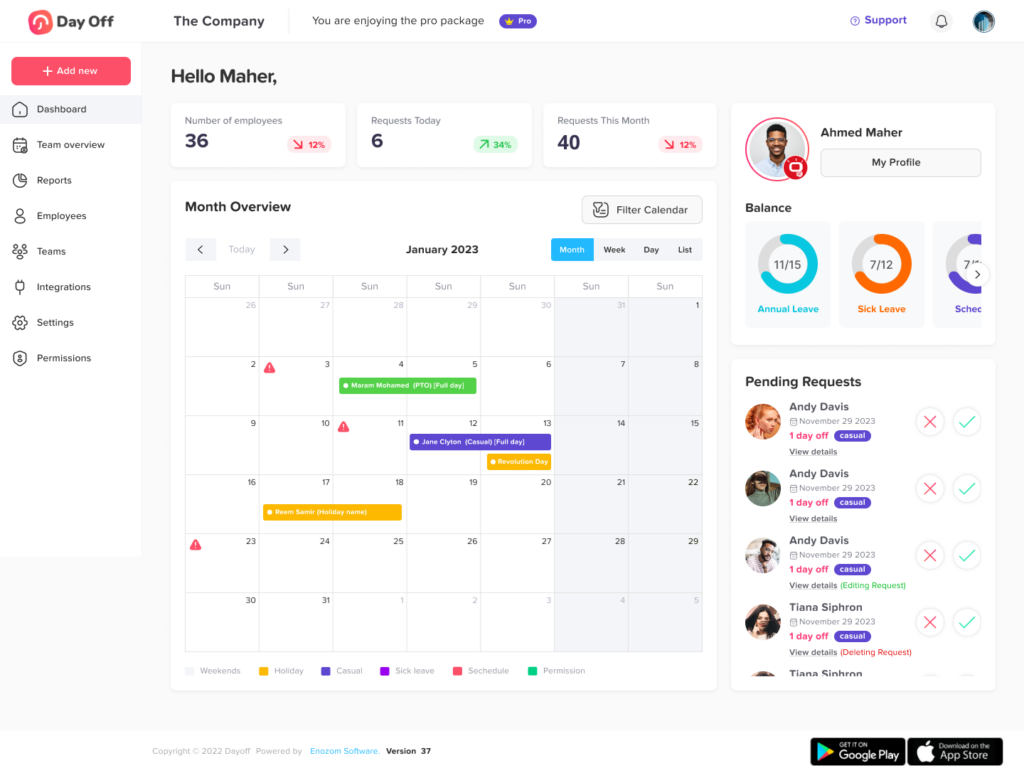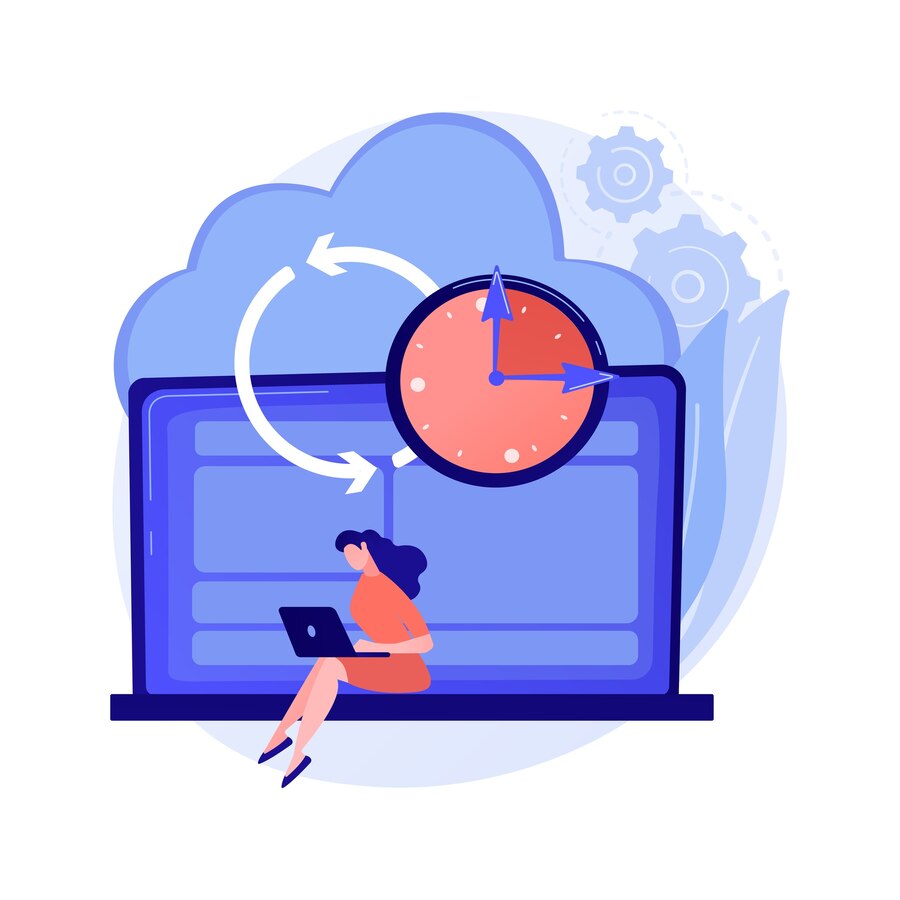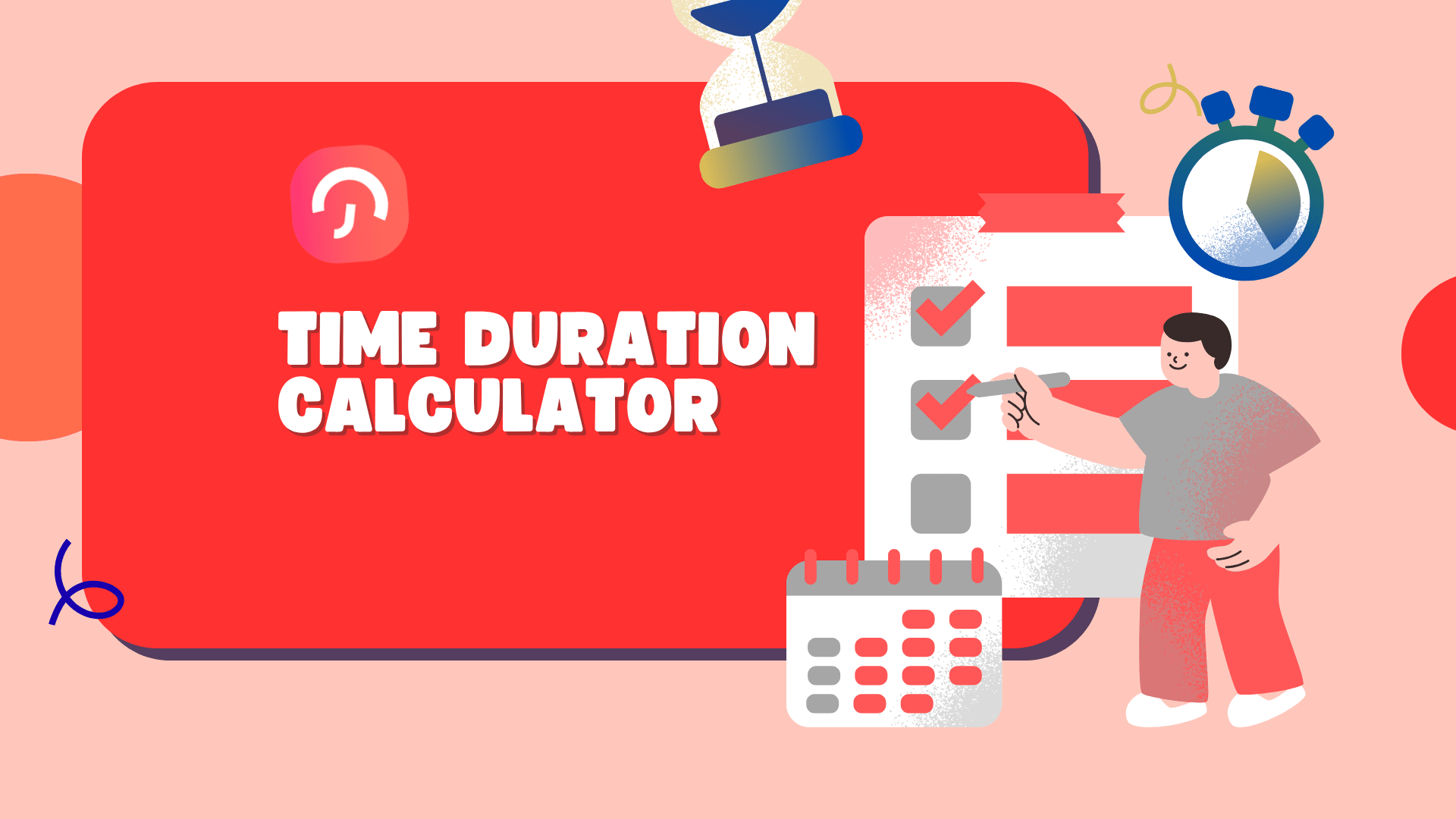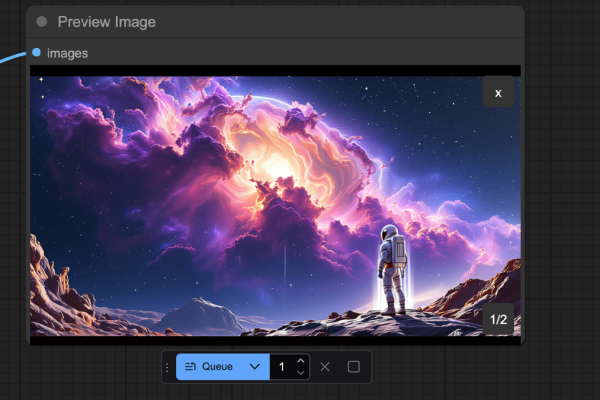Absenteeism is a critical issue that affects organizations across all industries. While employees occasionally miss work due to legitimate reasons such as illness, family emergencies, or personal obligations, excessive or unplanned absenteeism can lead to serious operational disruptions. It impacts productivity, increases workload for other employees, and can ultimately lead to financial losses for a business. To effectively manage attendance and maintain a well-functioning workplace, companies must establish a clear and enforceable absenteeism policy.
This policy ensures that employees understand expectations, reporting procedures, acceptable and unacceptable absences, and potential consequences for policy violations.
With the introduction of digital workforce management tools like Day Off, businesses can further streamline attendance tracking, leave management, and overall workforce planning. In this guide, we’ll explore the importance of an absenteeism policy, its key components, best practices for implementation, and how Day Off can help organizations enhance efficiency in managing employee absences.
Understanding Absenteeism
Absenteeism refers to the habitual, frequent, or prolonged absence of an employee from work, often without valid reason, prior notice, or approval. While occasional absences are a normal part of any workplace, chronic or unplanned absenteeism can disrupt operations, lower morale, and affect overall business performance.
Types of Absenteeism
Planned Absences:
These are scheduled and approved in advance, such as paid time off (PTO), vacations, medical leave, or other authorized leave types. Planned absences are typically accounted for within the company’s attendance and scheduling systems.Unplanned Absences:
These occur without prior notice or approval and are often caused by unforeseen circumstances such as sudden illness, family emergencies, or personal crises. Although sometimes unavoidable, frequent unplanned absences can create workflow disruptions.Chronic Absenteeism:
This involves repeated, unjustified absences over an extended period. Chronic absenteeism can signal deeper issues, such as disengagement, workplace dissatisfaction, or personal challenges, and requires proactive management and support from HR.
How Absenteeism Impacts Businesses
While occasional absences are to be expected, consistent absenteeism can have a serious impact on productivity, morale, and profitability. Some of the most common effects include:
Reduced Productivity
When employees are frequently absent, projects slow down, deadlines are missed, and team efficiency declines. The absence of key contributors can cause bottlenecks, forcing others to pause their work or take on unfamiliar tasks.
Increased Workload for Other Employees
When one employee is absent, their duties often fall on their coworkers. Over time, this added workload can lead to frustration, fatigue, and eventually burnout, further compounding the absenteeism problem.
Higher Operational Costs
Unplanned absences often require paying overtime to cover shifts, hiring temporary staff, or delaying critical business operations. These hidden costs can quickly add up, especially in industries with tight staffing requirements.
Lower Employee Morale
Persistent absenteeism within a team can create resentment and lower morale. Employees who consistently show up to work may feel undervalued or overburdened, especially if absentee behavior goes unaddressed.
Decline in Customer Service Quality
In customer-facing industries such as retail, hospitality, or healthcare, absenteeism directly affects service quality. Fewer available staff can mean longer wait times, mistakes, and dissatisfied customers, ultimately damaging brand reputation.
Why Every Company Needs an Absenteeism Policy
A clear and well-enforced absenteeism policy is crucial for maintaining fairness, accountability, and operational consistency. Such a policy helps:
Set clear expectations for attendance and communication.
Distinguish between acceptable and unacceptable absences.
Ensure that leave requests and approvals are handled consistently.
Provide guidelines for managing repeated or unexcused absences.
With modern tools like Day Off, businesses can automate attendance tracking, monitor absenteeism trends, and enforce policies consistently, all while maintaining transparency and supporting employee well-being.

Key Components of an Effective Absenteeism Policy
A well-crafted absenteeism policy establishes clear expectations, ensures accountability, and promotes fairness across the organization. It helps both employees and managers understand what constitutes acceptable absences, how to report them, and what actions will follow if attendance issues arise.
Below is a detailed breakdown of the key elements every absenteeism policy should include:
Purpose and Scope
Begin your policy by explaining why it exists and who it applies to. This section sets the foundation for consistency and transparency across all teams.
Example:
“This policy outlines the attendance and absenteeism expectations for all full-time, part-time, and contract employees at [Company Name]. It applies to all departments and office locations to ensure fairness, accountability, and smooth business operations.”
Clearly defining the scope helps avoid ambiguity and ensures every employee understands their obligations.
Attendance Expectations
Outline your company’s standards for attendance, punctuality, and availability. This section should clarify what “being present” means in your workplace, whether employees are in-office, hybrid, or remote.
Key Guidelines:
Employees are expected to be present, ready, and prepared to work at their scheduled start time.
Late arrivals exceeding 15 minutes require prior notification to a manager or HR.
All absences must follow the company’s approved reporting procedure.
Repeated tardiness or leaving early without authorization may be treated as attendance violations.
Setting clear expectations ensures fairness and consistency while giving managers a solid framework to address attendance concerns.
Notification & Reporting Procedures
Employees must know exactly how to report an absence. This section defines the communication protocol and timeframes for notifying supervisors or HR.
Include Details Such As:
Who to Contact: Direct supervisor, HR department, or team lead.
How to Notify: Via phone call, email, or company HR system (e.g., Day Off).
When to Notify: At least one hour before the scheduled start time unless it’s an emergency.
Example Policy Statement:
“Employees must notify their immediate supervisor via phone or email at least one hour before their scheduled start time if they are unable to report to work. Repeated failure to follow the notification procedure may result in disciplinary action.”
This ensures absences are recorded promptly and fairly, reducing confusion or miscommunication.
Acceptable vs. Unacceptable Absences
Not all absences are treated equally. It’s important to differentiate between authorized and unauthorized absences to ensure transparency and fairness.
Acceptable Absences (with proper documentation):
Approved PTO (vacation days, personal leave, etc.)
Sick leave (doctor’s note required for absences longer than two days)
Bereavement leave (leave following the death of an immediate family member)
Jury duty or legal obligations
Unacceptable Absences:
No-call, no-show (failure to notify the company of absence)
Leaving work early or arriving late without authorization
Excessive unverified sick leave or vague personal excuses
Absences during critical business periods without approval
By clarifying these categories, the company sets clear expectations and minimizes the chance of disputes.
Documentation Requirements
To maintain accountability and compliance, employees may need to provide documentation for specific types of absences.
Examples of Required Documentation:
Medical Leave: Doctor’s note for absences longer than two consecutive days.
Jury Duty: Official court summons or attendance certificate.
Bereavement Leave: Proof of loss (if required under company policy).
This helps HR verify absences fairly while protecting both the company and employees from misunderstandings.
Consequences of Excessive Absenteeism
Every absenteeism policy should clearly outline the steps that will be taken if attendance issues continue. A progressive disciplinary system promotes accountability while allowing opportunities for correction.
Suggested Disciplinary Process:
Verbal Warning: Initial discussion to address attendance issues.
Written Warning: Formal notice if absenteeism continues.
Performance Improvement Plan (PIP): Structured plan with specific attendance goals and timelines.
Final Warning / Probation: Last opportunity to correct behavior before termination.
Termination: If absenteeism persists despite prior warnings and interventions.
A structured process ensures fairness, documentation, and compliance with employment laws.
Return-to-Work Procedures
For extended absences (especially medical-related ones), employees should follow a defined process before resuming work.
Typical Requirements:
Submit a fitness-for-duty certificate from a licensed medical professional.
Attend a return-to-work meeting with HR or their manager to discuss any necessary accommodations.
Update their availability or modified duty requirements in the system (e.g., Day Off).
These measures support both employee safety and operational continuity.
Employee Support & Assistance
An effective absenteeism policy doesn’t just enforce rules — it also supports employees in managing their well-being. Providing flexibility and resources can prevent absenteeism from becoming a recurring issue.
Recommended Support Options:
Flexible Work Arrangements: Remote work, hybrid schedules, or flexible hours.
Employee Assistance Programs (EAPs): Access to counseling, stress management, or wellness services.
Digital Leave Management Tools: Use software like Day Off to make PTO requests, absence tracking, and approvals fast and transparent.
Encouraging employees to use their leave responsibly promotes a healthier work-life balance and improves overall morale.
Leveraging Day Off for Absence Tracking
Integrating a digital attendance tool like Day Off makes absenteeism management seamless and efficient. With real-time tracking, customizable leave types, and automated notifications, companies can:
Accurately monitor attendance trends.
Approve or deny requests instantly.
Generate detailed reports for HR and payroll.
Identify early warning signs of chronic absenteeism.
By automating tracking and compliance, Day Off helps HR teams spend less time on manual record-keeping and more time supporting employee engagement and well-being.
Day Off: The Ultimate Workforce Attendance Management Solution
Managing employee attendance doesn’t have to be complicated. Day Off is a powerful, intuitive, and easy-to-use digital solution that simplifies every aspect of time-off management, from PTO tracking to absence monitoring and work schedule coordination.
Whether you’re managing a small startup or a large multi-location enterprise, Day Off helps you stay organized, boost transparency, and ensure smooth workforce operations, all from one centralized platform.
Why Choose Day Off?
Effortless PTO Management
Say goodbye to endless email threads and manual approvals. With Day Off, employees can submit time-off requests in seconds, and managers can approve or decline them instantly with a single click. Automated notifications keep everyone informed, eliminating confusion and reducing administrative delays.
Customizable Work Schedules
Every team has different scheduling needs, and Day Off adapts to them all. Create and modify work schedules for departments, shifts, or remote teams effortlessly. This ensures precise leave tracking, better workload distribution, and more effective resource planning throughout the organization.
Automated Absence Tracking
Manual attendance tracking is prone to errors and takes valuable time away from HR teams. Day Off automates the process, maintaining real-time records of absences and leave balances. It also helps ensure compliance with your absenteeism policy by accurately recording each type of leave, whether it’s PTO, sick leave, or unpaid time off.
Instant Attendance Insights
Gain full visibility into your workforce at any moment. With Day Off’s real-time dashboard, managers can see who’s working, who’s on leave, and how absences impact team capacity. This makes shift planning and project scheduling more seamless and data-driven, helping prevent staffing gaps and last-minute disruptions.
Compliance & Documentation Made Simple
Keeping up with attendance records and labor law requirements can be complex, but Day Off makes it effortless. The platform automatically maintains detailed digital records of employee leave, ensuring full compliance with company policies and legal standards. HR teams can generate reports for audits, payroll processing, or performance reviews in just a few clicks.
Best Practices for Implementing an Absenteeism Policy
Clearly Communicate the Policy
Make sure every employee fully understands the attendance policy from day one. Incorporate it into onboarding sessions, employee handbooks, and internal HR portals. Reinforce awareness through periodic reminders and team meetings to prevent confusion or misinterpretation.
Enforce Consistently and Fairly
Apply attendance rules uniformly across all teams and departments. Consistency builds trust and ensures fairness, while also protecting the company from potential legal or HR disputes. Managers should lead by example and uphold the same standards they expect from their teams.
Leverage Technology for Efficiency
Use modern HR tools like Day Off to automate PTO tracking, absence monitoring, and approval workflows. This eliminates manual errors, saves valuable time, and provides real-time visibility into employee availability, helping managers plan better and stay compliant effortlessly.
Promote a Healthy Work Culture
Encourage open dialogue about workload and well-being. Recognize employees with strong attendance records, and offer flexibility where possible, such as hybrid work options or mental health days. A supportive culture not only reduces absenteeism but also boosts morale and engagement.
Regularly Review and Update the Policy
Workplaces evolve, and your absenteeism policy should too. Review it periodically to ensure it aligns with changing business priorities, employee expectations, and updated labor laws. Solicit feedback from managers and staff to keep the policy practical, fair, and effective.
(FAQ) About Absenteeism Policy & Day Off
What is the difference between absenteeism and tardiness?
Absenteeism occurs when an employee is completely absent from work, whether it’s a planned leave (like PTO or medical leave) or an unplanned one (such as a sick day or a no-call, no-show situation).
Tardiness, on the other hand, refers to arriving late for work or returning late from breaks. While it might seem less serious, habitual tardiness can disrupt team workflows and decrease productivity over time.
Both behaviors can be early indicators of disengagement or burnout, so tracking and addressing them promptly is essential.
How can companies handle employees with chronic absenteeism?
Consistent absenteeism can be a sensitive issue, and companies should approach it with a balance of empathy and accountability. A structured approach works best:
Identify the cause: Hold a private, judgment-free conversation to uncover the underlying reason, it could be personal, medical, or work-related.
Provide support: Offer flexible scheduling, wellness resources, or Employee Assistance Programs (EAPs) if appropriate.
Issue formal warnings: If absenteeism continues, implement progressive discipline, verbal warning, written notice, probation, and, if necessary, termination.
Leverage technology: Tools like Day Off help HR teams track attendance trends, identify early warning signs, and manage interventions more effectively.
Can Day Off track different types of leave?
Yes! Day Off supports multiple leave types, including:
Paid Time Off (PTO)
Sick Leave
Parental or Maternity Leave
Bereavement Leave
Jury Duty
Unpaid Leave
Managers can fully customize leave categories to align with company policies, ensuring accurate and compliant record-keeping.
How does Day Off handle last-minute absences?
When an unexpected absence occurs, employees can instantly submit a last-minute leave request through the Day Off app.
Managers receive real-time notifications so they can respond quickly, reassign tasks, and adjust schedules with minimal disruption.
This ensures business continuity and fair communication during unplanned absences.
What should a company do if an employee doesn’t report their absence?
A no-call, no-show is a serious violation of attendance policy. Companies should:
Attempt to contact the employee immediately to check for emergencies.
Document the missed day in their records.
Issue a formal warning or follow disciplinary protocols if it happens repeatedly.
Using Day Off helps HR teams monitor attendance patterns, document incidents, and maintain consistent enforcement across the organization.
Can employees request half-day or shift swaps in Day Off?
Yes. Day Off gives employees flexibility to:
Request half-day or partial-day leave for short absences.
Propose shift swaps with colleagues (depending on company policy).
This flexibility supports both operational needs and employee convenience, especially for hybrid or shift-based teams.
Does Day Off integrate with payroll systems?
Absolutely. Day Off integrates seamlessly with popular payroll platforms, ensuring accurate:
Leave deductions
Overtime calculations
Salary adjustments based on attendance data
This eliminates manual data entry, reduces payroll errors, and saves HR teams valuable time each pay period.
Can companies customize Day Off to fit their attendance policies?
Yes. Day Off is designed to adapt to each organization’s unique attendance and absenteeism rules. Businesses can:
Define custom leave categories and accrual rates
Set different schedules for departments or shifts
Configure approval workflows
Adjust notification preferences and access levels
This flexibility ensures the platform aligns perfectly with internal policies and labor law requirements.
How can managers prevent burnout while enforcing an absenteeism policy?
A strong attendance policy should also promote employee well-being. Managers can prevent burnout by:
Allowing reasonable flexibility in scheduling.
Encouraging employees to use their PTO proactively.
Offering wellness initiatives or mental health days.
Monitoring workloads using Day Off analytics to identify overworked teams.
Balancing discipline with empathy fosters a healthier and more sustainable work culture.
How secure is employee attendance data in Day Off?
Data privacy and security are top priorities for Day Off. The platform employs:
End-to-end encryption to protect sensitive employee data.
Access controls so only authorized users can view attendance records.
Cloud-based storage with automatic backups to prevent data loss.
These measures ensure compliance with global data protection standards and give employers complete peace of mind.
How can companies transition from manual attendance tracking to Day Off?
Switching to Day Off is fast and simple. Companies can:
Import existing attendance records into the platform.
Set up employee profiles and custom leave policies.
Train staff and managers through guided onboarding sessions.
Start managing PTO, absences, and schedules in real time.
Most organizations experience immediate efficiency improvements, reduced errors, faster approvals, and clearer visibility across teams.
What if multiple employees request time off at the same time?
Day Off helps managers handle overlapping requests efficiently by:
Displaying a real-time team calendar showing who’s already scheduled off.
Allowing managers to approve or decline requests based on availability.
Setting limits on simultaneous absences to ensure adequate staffing.
This visibility ensures fair decision-making and uninterrupted operations.
How can Day Off help ensure compliance with labor laws?
Many labor regulations require accurate record-keeping of employee absences and leave entitlements. Day Off helps companies stay compliant by:
Automatically tracking accruals, entitlements, and usage.
Storing attendance data securely for audits and disputes.
Applying region-specific rules for PTO, overtime, and public holidays.
This automation minimizes legal risks and simplifies compliance management for HR teams.
Can Day Off generate reports for performance reviews or HR audits?
Yes. Day Off includes advanced reporting and analytics tools that generate insights such as:
Attendance trends and punctuality records.
PTO usage and remaining balances.
Departmental absenteeism rates.
Historical data for performance appraisals and workforce planning.
These reports help managers make informed, data-driven decisions about productivity, engagement, and performance management.
How should companies handle employees with ongoing medical conditions?
If an employee has a chronic illness or disability that leads to frequent absences, employers should:
Offer reasonable accommodations, such as flexible hours or remote work options.
Maintain compliance with disability and medical leave laws.
Use Day Off to categorize and document medical absences separately, ensuring fair and accurate record-keeping.
By handling such cases sensitively and systematically, employers can protect both their team’s well-being and their organization’s compliance posture.
Conclusion
Managing absenteeism effectively requires both structure and empathy, and that’s where Day Off makes all the difference.
The platform empowers HR teams to monitor attendance, prevent scheduling conflicts, and maintain compliance, all while promoting employee well-being and transparency.
With its automation, customization, and seamless integrations, Day Off turns attendance management from a tedious chore into a strategic advantage.
Ready to simplify your absenteeism management? Start using Day Off Leave Tracker today and transform the way your team handles attendance.























